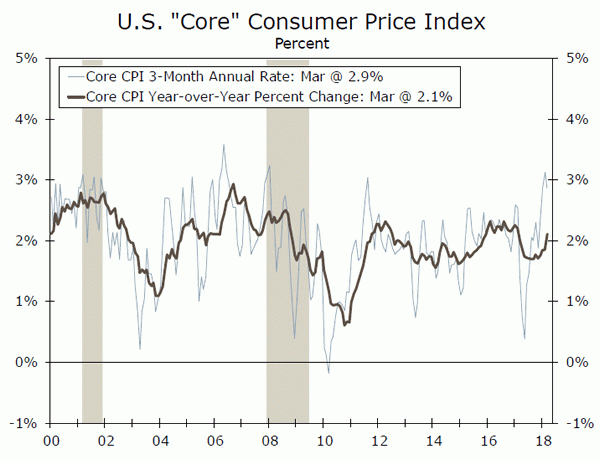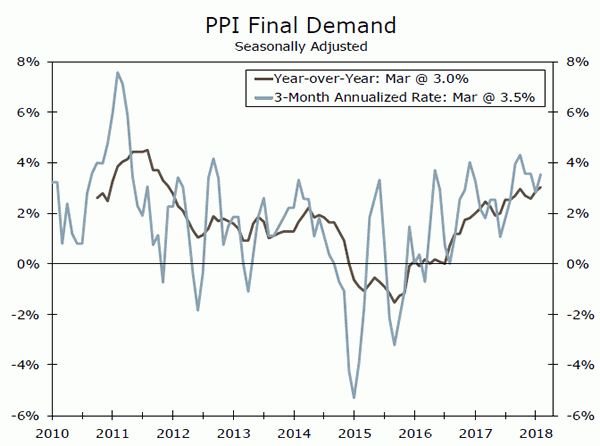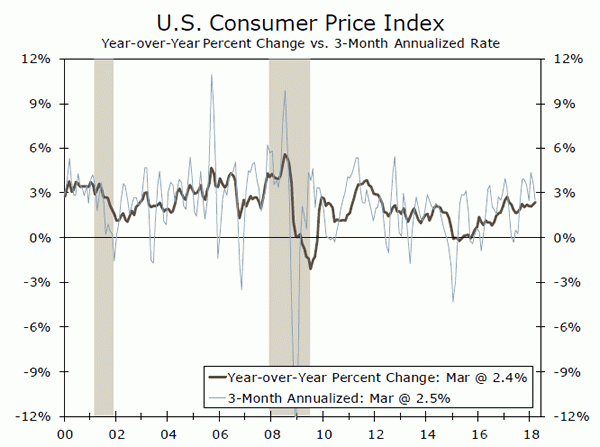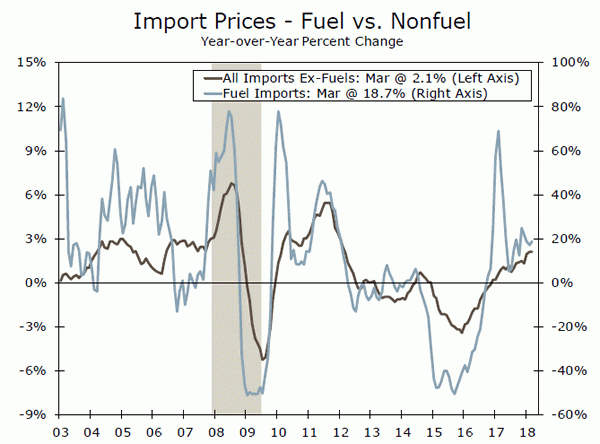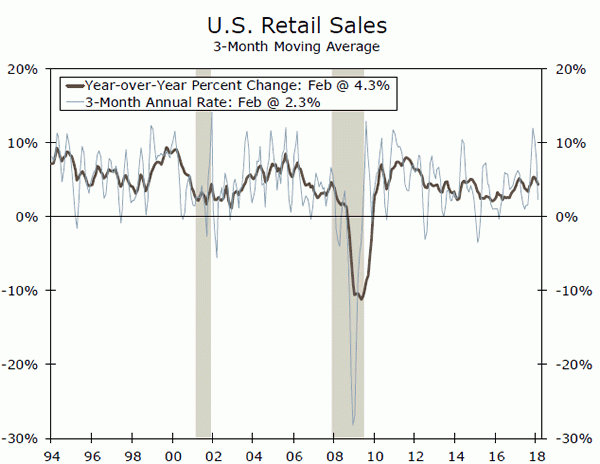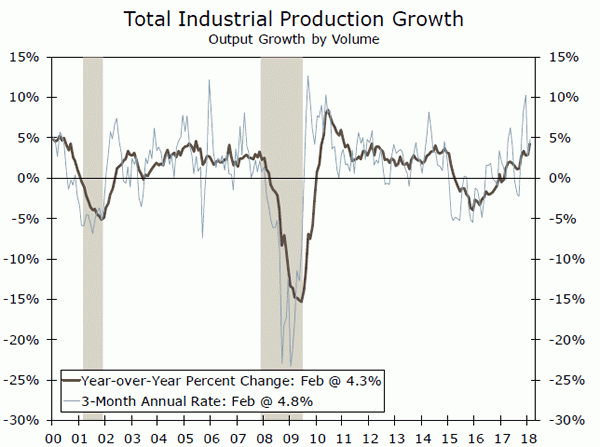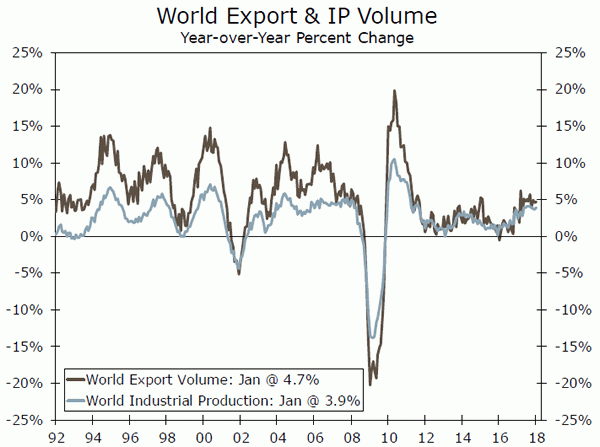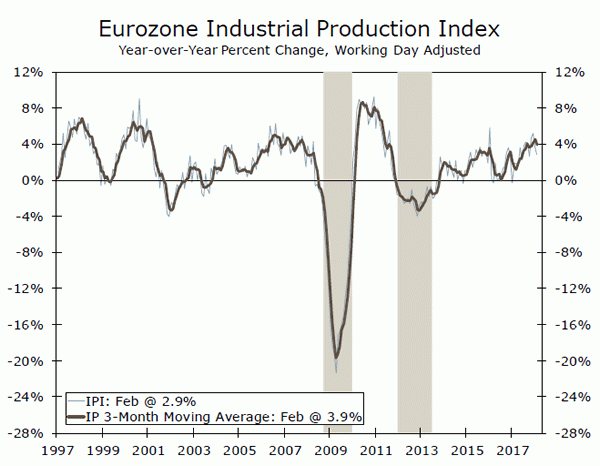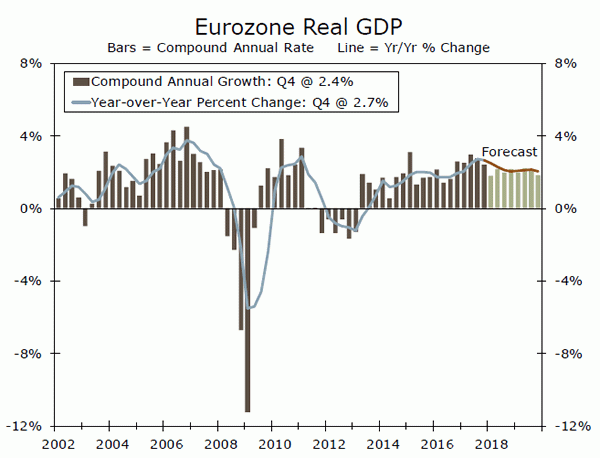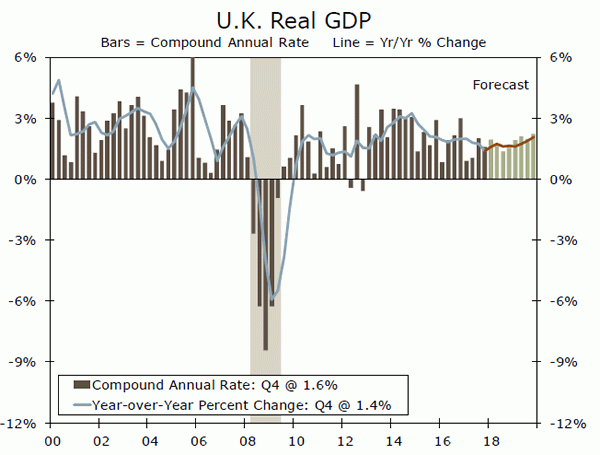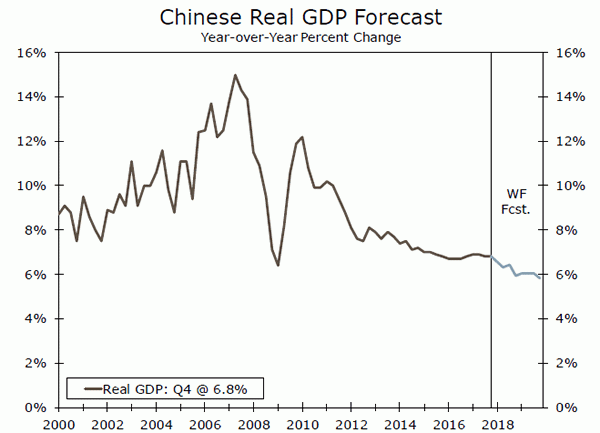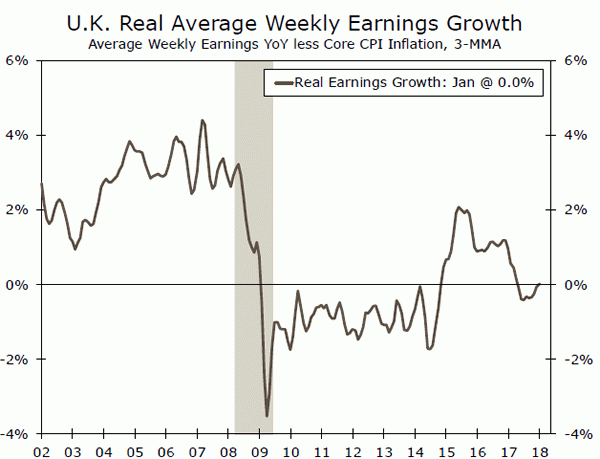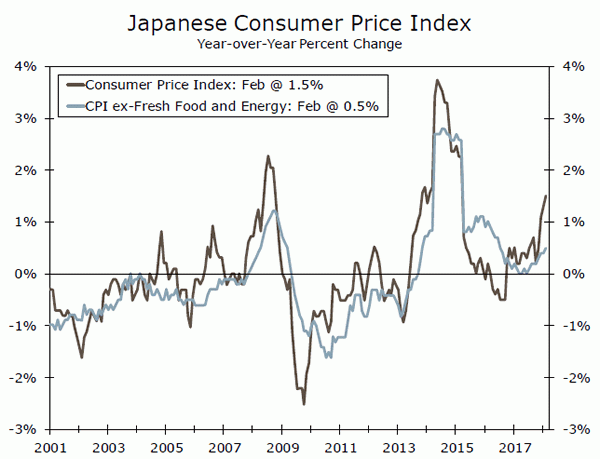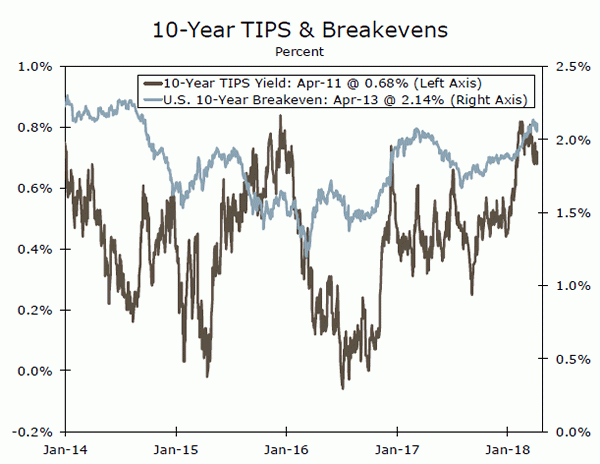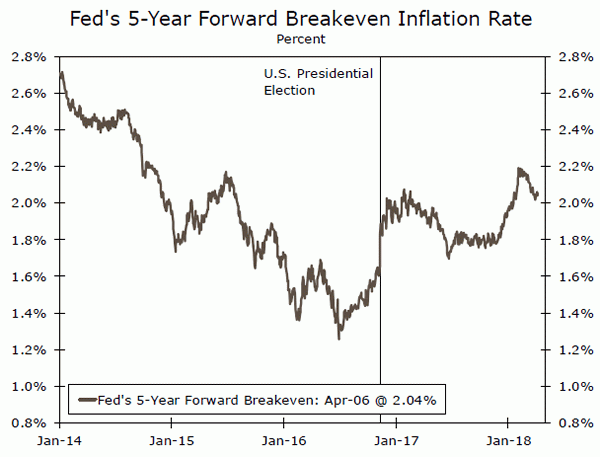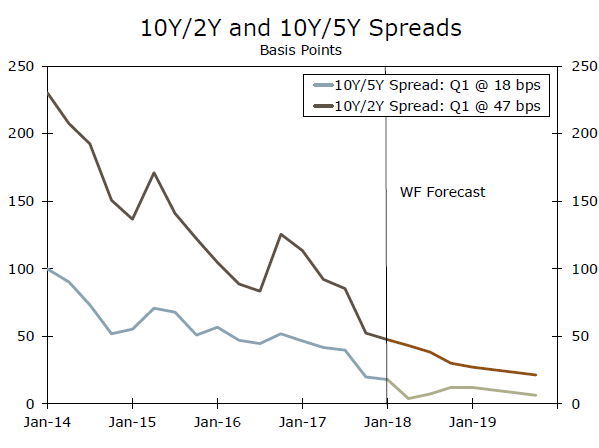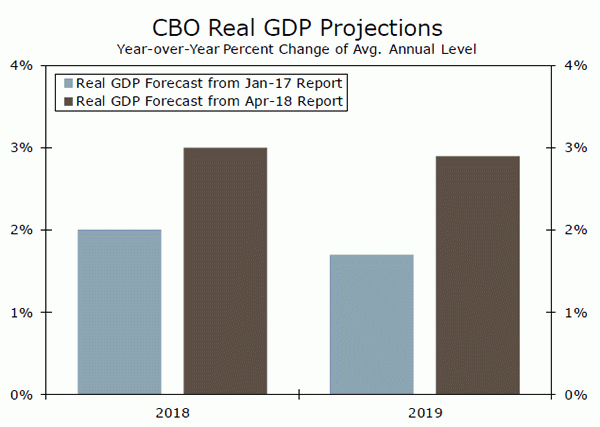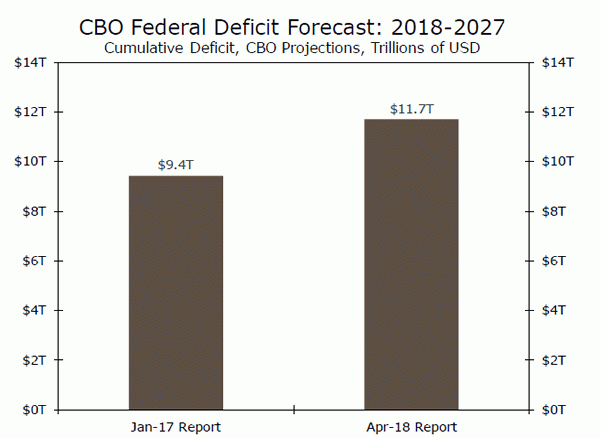U.S. Review
Firming Inflation Favors June Rate Hike
- Market participants were greeted this week with three unique inflation indicators. Looking beyond the headline figures, the releases reveal broad-based price firming in the economy.
- Core CPI has increased at a 2.9 percent annual rate over the past three months – core services strengthened 0.3 percent on the month led by a rebound in shelter costs.
- Producer prices are up 3.0 percent year over year, further supporting the narrative of firming prices across the economy. Strengthening prices support a June rate hike.
Inflation Measures Dominate Data Wire
Market participants this week eagerly awaited the release of three carefully watched inflation metrics: the producer price index, the consumer price index and the import price index. Observers who were hoping for signs of firming inflation were not disappointed. The inflation celebration, albeit a restrained one, was kicked off on Tuesday with the release of March’s producer price index (PPI), which rose 0.3 percent ahead of expectations for a 0.1 percent gain. Besides the energy component, all major sub-sectors saw prices rise last month. Moreover, this now marks the third straight month that the PPI for services advanced upward. Our preferred measure of core PPI rose 0.4 percent and points to the underlying trend in inflation continuing to strengthen.
Perhaps the most highly anticipated economic indicator this week was released on Wednesday morning–the consumer price index (CPI) report for March. Although the headline figure fell 0.1 percent, the decline can be entirely traced to energy, where prices fell 2.8 percent. Elsewhere, however, price gains were stronger and point to firming inflation. After what had been the strongest three-month run in 10 years, the core index increased an impressive 0.2 percent. Core services strengthened 0.3 percent, led by a rebound in shelter costs. Prices for medical services also strengthened notably, up 0.5 percent, after being flat last month.
It was this time last year that core inflation posted a surprising decline due to the now-infamous drop in wireless services. The index fell 0.1 percent – a rare event outside of a recession. With the drop now a full year behind us, the 12-month rate of core inflation jumped to 2.1 percent from 1.8 percent. Even through the 12-month change has been helped by an easy base comparison, we believe there is more strength to come even without such a favorable base effect over the next few months. Core CPI has increased at a 2.9 percent annual rate over the past three months, and we look for the core index to increase 2.2 percent year-overyear in the second quarter. The third inflation metric, the import price index, was generally flat on the month in an otherwise pricefirming environment. Fuel imports fell for the second month in a row, but are still up over the year. Despite the soft headline figure, ex-petroleum import prices rose 0.1 percent on the month.
Recent months have witnessed a heightened level of anxiety surrounding a potential trade war with China. Fiery rhetoric from various figures have spooked markets and raised fears of heightened import prices as a result of tariffs. However, import inflation brought on by a possible trade war would likely be seen as transitory by the Fed. Furthermore, the Fed’s main focus is with consumer price inflation. FOMC Chair Powell and other members are certainly aware of the aforementioned favorable arithmetic surrounding the year-ago rate of core inflation, so the jump witnessed in March is unlikely to alter their overall view of inflation. What we believe is likely to be more influential in the Fed’s thinking is the overall strength that has prevailed since late last year, as well as broadening indications of higher input costs for labor and raw materials.
U.S. Outlook
Retail Sales • Monday
Retail sales have gotten off to a slow start in 2018, falling 0.1 percent in January and February. The sectors that were the biggest drags on retail sales in February were motor vehicle & parts dealers’ sales, furniture & home furnishing sales and electronics & appliance store sales. Gasoline stations’ sales also declined in February, by 1.2 percent, despite higher gasoline prices in the month. Sectors that showed positive growth included sporting goods, hobby, book & music stores’ sales, building material sales and clothing & clothing accessories sales.
The first two retail sales reports of 2018 indicate that consumption may have slowed during the first quarter of the year. Control group sales, which go directly into GDP calculations, were flat in January and below consensus in February. Despite the weakness during the first two months, we remain positive on the consumer this year, with accelerating inflation posing the greatest downside risk.
Previous: -0.1% Wells Fargo: 0.3% Consensus: 0.4% (Month-over-Month)
A dramatic drop in multifamily starts of 26.1 percent in February pulled the headline reading down to a 7.0 percent drop on the month. This masked a 2.9 percent gain in single-family housing starts, as new home construction gains momentum. This solid gain followed a 3.5 percent gain in January. The South and West have contributed the vast majority of single-family starts, accounting for 77 percent of the nation’s total in 2017. Unseasonably mild winter weather in these regions to start the year has boosted starts, while the Midwest and Northeast have lagged due to harsher winter conditions.
The housing recovery has been sluggish, as shortages of lots and workers have held back starts. Higher building material prices have also made it more difficult to build entry-level homes as profit margins are crimped. However, momentum seems to be building over the past year and we look for the pace of housing starts to continue to trend higher.
Previous: 1,236K Wells Fargo: 1,268K Consensus: 1,269K
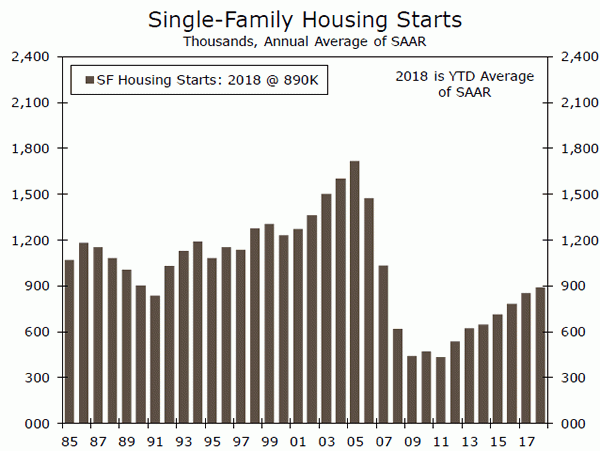 Industrial Production • Tuesday
Industrial Production • Tuesday
Industrial production surged 0.9 percent in February, finally indicating a convergence between output and strong soft data readings in the manufacturing sector. All major categories increased in the month, with motor vehicles and parts gaining roughly 4.0 percent. For months, hard data have lagged behind survey measures such as small business confidence, purchasing manager surveys and the ISM survey. This month’s report is an encouraging development for industrial production.
Mining output jumped 3.5 percent in February, which is the largest increase in almost 10 years. Utilities, on the other hand, declined 4.9 percent as a warm February weighed on demand. This surge in industrial production pushed up capacity utilization. Manufacturing utilization is currently at a cycle-high at 75.9 percent. While this utilization is still below the high of the prior cycle, it is above the 20-year average of 75.5 percent.
Previous: 0.9% Wells Fargo: 0.3% Consensus: 0.3% (Month-over-Month)
Global Review
Is Global Economic Growth Slowing?
- Industrial production in the euro area fell for the second consecutive month in February, which means that IP likely contracted in Q1. Although weather likely played a role in depressing IP in the first quarter, the acceleration phase of the current cycle in the euro area has likely passed.
- IP in the United Kingdom only edged higher in February, and a widely respected British think tank estimates that overall real GDP growth in the first quarter was weak. Although we are not forecasting a recession, we look for British growth to remain underwhelming throughout most of this year.
Is Global Economic Growth Slowing?
After a lackluster 2016, global economic activity accelerated in 2017. Not only did growth in global industrial production (IP) strengthen last year but so too did growth in global trade volumes (see graph on front page). However, as discussed in our “Monthly Economic Outlook”, we estimate that the sequential rate of real GDP growth in the United States downshifted markedly in the first quarter. Incoming data similarly indicate that GDP growth in some other major economies slowed as well in Q1.
Let us start in the Eurozone where IP slumped 0.8 percent in February following the 0.6 percent drop that was registered in January. Unless IP rebounded 2.1 percent or more in March, which seems like a tall order, it will have contracted in Q1-2018. Some of the weakness in IP in February reflects unusually cold weather, and IP remains up nearly 3 percent relative to last year (top chart).
Although we estimate that real GDP growth in the first quarter was positive—output in the service sector, which accounts for the lion’s share of value added, likely remained resilient—the Eurozone is unlikely to match the 0.6 percent (not annualized) GDP growth rate that it churned out in Q4-2017. Indeed, we believe the acceleration phase of the current cycle in the euro area has now passed. We are not saying that the Eurozone is slipping back into recession. We are just saying that real GDP growth will slow back to a more “normal” rate. In that regard, real GDP in the euro area was up 2.7 percent in Q4-2017, the strongest year-over-year growth rate in more than six years. We forecast that it will slow to 2 percent by the end of 2018 (middle chart).
Real GDP growth in the United Kingdom also appears to have been muted in the first quarter. For starters, IP edged up only 0.1 percent in February as production in the manufacturing sector fell for the first time in 11 months. (Strength in utilities, which reflects the unusually cold weather noted above, kept overall IP growth in positive territory.) Meanwhile, output in the construction sector tumbled 1.6 percent in February, which followed on the heels of the 3.1 percent decline registered during the previous month.
A widely respected think tank, National Institute of Economic & Social Research (NIESR) announced this week that it estimates that British real GDP grew only 0.2 percent (not annualized) in the first quarter. If confirmed by official data that will be released later this month, it would represent a marked slowdown from the 0.4 percent sequential rate that real GDP grew in Q4-2017.
We are not as pessimistic as the NIESR about the U.K.’s growth performance in Q1, although we do acknowledge some downside risk to our current estimate of 0.5 percent sequential growth. Uncertainty related to Brexit appears to have constrained real GDP growth in the United Kingdom in recent quarters, and we look for British growth to remain underwhelming throughout most of this year (bottom chart).
Global Outlook
China GDP • Tuesday
The Bloomberg consensus once again expects Chinese GDP growth to print at 6.8 percent year over year for Q1-2018. If realized, this would mark the third consecutive reading of 6.8 percent and the 11th consecutive quarter economic growth has been +/- 0.1 percentage point from 6.8 percent. Based off of monthly data available through February, it appears a pick-up in industrial output and investment spending relative to Q4 helped offset some modest cooling in personal consumption. It will be interesting to see what kind of momentum Chinese international trade had in Q1 at the onset of the recent trade flare-up between China and the United States.
Despite steady growth in Q1, our expectation is that Chinese real GDP growth will continue to gradually slow over the coming quarters amid an aging population, decelerating investment and deleveraging efforts. We look for real GDP growth of 6.3 percent in China in 2018 before slowing further to 6.0 percent in 2019.
Previous: 6.8% Wells Fargo: 6.6% Consensus: 6.8% (Year-over-Year)
U.K. Consumer Price Index • Wednesday
A slew of important data on the United Kingdom economy are reported next week. Data on U.K. employment and earnings print next Tuesday, followed by the CPI on Wednesday and retail sales on Thursday. Inflation continues to be key to the outlook for the Bank of England, as the United Kingdom is one of the few advanced countries where inflation is currently running well above the central bank’s target. Recently, inflation has shown signs of turning over as the effect from the pound’s sharp depreciation following Brexit has gradually begun to fade.
Accelerating prices and stagnant nominal wage growth drove a deceleration in real wages that has recently shown some nascent signs of reversing. Retail sales volumes declined in December and January but rebounded in February, and next week’s data for March will show if U.K. consumers carried that momentum into the end of the first quarter.
Previous: 2.7% Wells Fargo: 2.6% Consensus: 2.7% (Year-over-Year)
Japan CPI • Thursday
Economic conditions in Japan have clearly firmed over the past few quarters. Japan has registered its longest period of uninterrupted growth since the 1986 expansion, and headline and core inflation have risen from recent lows. This improvement, coupled with gradually tightening monetary policy elsewhere in the advanced world, has led some to start questioning when the Bank of Japan (BoJ) might start the process of unwinding its extraordinary easing.
BoJ Governor Haruhiko Kuroda noted at a news conference this week that the BoJ will “need to eventually consider kicking off a process towards policy normalization.” For now, however, inflation remains well short of the BoJ’s 2 percent target, as it has for much of the past two decades. Given the structural economic challenges in Japan and the continued gulf between realized inflation and the 2 percent target, we expect the BoJ to remain committed to its current monetary policy stance for the foreseeable future.
Previous: 1.5% Wells Fargo: 1.2% Consensus: 1.1% (Year-over-Year)
Point of View
Interest Rate Watch
Rising Inflation, Flatter Yield Curve
One of the interesting developments in the credit market is the expectation of rising inflation in the future, yet a lower risk premium to cover higher prices. Breakevens for the 10-year Treasury have risen since early 2016 and even more so since the start of this year (top graph). This breakeven represents the spread between the nominal interest rate and the real interest rate. Meanwhile, the TIPS yield (also top graph) has risen even more since mid-2016, with a spike in early 2018. This would reflect a market expectation for a rising real yield. The breakeven and TIPS yields would support the case for a higher 1o-year rate going forward. Our outlook is for a continued rise in the 10-year rate for 2018 and into 2019.
Inflation Outlook: Next Five Years
Looking further ahead, the Fed’s five-year forward breakeven measure indicates that inflation expectations have risen since mid- 2016 and jumped at election time. Since the start of 2018, this measure of inflation expectations has moved up even more. This is quite a contrast to the decline in this series from January 2014 to mid-2016.
Yet a Flatter Yield Curve
As illustrated in the bottom graph, the yield curve, shown by the 10Y/2y and 10y/5Y spreads, has flattened since early 2014. This would appear unusual given that inflation expectations, measured by breakevens and five-year forwards, have actually risen, along with the TIPS measure of real yield. Moreover, recent reports from the Congressional Budget Office project a higher budget deficit going forward, which should also likely boost net Treasury issuance in the coming quarters. How do we reconcile these conflicting factors?
Our outlook is that the FOMC’s path to higher short-term rates would push the twoyear yield to 2.90 percent by the end of this year, compared to a rise in the 10-year yield to 3.20 percent. The FOMC’s moves would more than offset the fundamental factors driving the rise in longer term rates. It also appears that markets are not yet fearing the financing challenge of a larger federal deficit, currently leading short-term rates to rise faster than long-term rates.
Student Loan Growth Slows
U.S. households held $1.4 trillion in student debt in Q4-2017, 5.2 percent more than a year earlier. This growth rate is the lowest since the New York Fed began recording the series in 2004. Consistently high growth rates over the past decade, however, mean that the volume of student debt remains more than double its level in 2008.
Student debt has registered some of the fastest growth rates of all types of debt in this expansion; student loan balances grew consistently above 10 percent a year in 2009-2014, even as households reduced mortgage, auto and credit card debt postrecession. Student debt made up less than 4 percent of household debt in 2005, but the share has since ballooned to 10.5 percent.
The growth rate of student debt has moderated recently, falling by roughly half over the past 2 years. Contributing to slower student loan growth is a shrinking collegeage population—the number of 20-24 year olds fell 300,000 (1.4 percent) in 2016, after declining for the first time since 1996 in 2015. Student loan originations are also down in each of the past two years.
While the number of new borrowers is shrinking, many existing borrowers are still struggling to pay back their loans. At 11 percent, the delinquency rate on student loans is the highest of all debt categories, and has stayed about constant since 2012 despite gains in household incomes and wealth. Student loans make up about 30 percent of all new seriously delinquent loans (90 or more days late).
Topic of the Week
Sizing Up the Budget and Economic Outlook
The Congressional Budget Office (CBO) released its 10-year Budget and Economic outlook earlier this week. The report was more highly anticipated than usual as CBO’s last update occurred in June 2017, before the tax cut and spending bills were enacted into law. In short, yesterday’s release showed large upward revisions to economic growth and the federal budget deficit in the short-run. Over the long-run, CBO continues to expect a deteriorating fiscal outlook and potential GDP growth between 1.75 and 2.0 percent.
Perhaps most surprising was CBO’s bullish short-term economic growth estimates. As seen in the top chart, the outlook for this year and next has significantly improved relative to CBO’s expectations 14 months ago. CBO anticipates 3.0 percent real GDP growth in 2018 (measured as a year-over-year percentage change of the annual average level) and 2.9 percent in 2019. This contrasts with our expectation for 2.6 percent growth this year and 2.9 percent in 2019. Using the Fed’s Q4 over Q4 convention, CBO’s forecast for 2018 is not only higher than the FOMC median but would be the highest among the 15 FOMC submissions by 0.3 percentage points.
Regarding the budget deficit, CBO’s forecast is roughly in-line with our own. For FY 2018, CBO expects a deficit of $804 billion, slightly larger than our forecast of $775 billion. For FY 2019, CBO looks for a deficit of $981 billion, a bit below our $1.1 trillion forecast. Like ours, CBO’s deficit forecast has risen dramatically over the past year even as the outlook for economic growth has improved. CBO now expects the cumulative deficit over 2018-2027 to be $11.7 trillion, up from $9.4 trillion as of last January (bottom chart). If this baseline scenario unfolds, net Treasury issuance over the next decade would nearly double the size of today’s roughly $15 trillion Treasury market.




